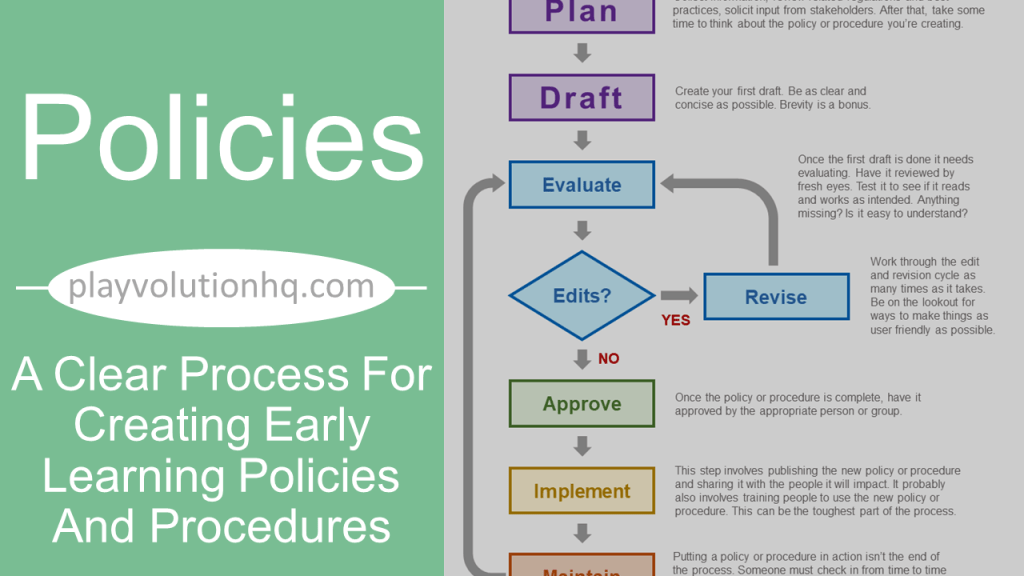
Creating early learning policies and procedures can be time-consuming and daunting. This post lays out a clear process for creating, updating, and managing your early learning setting’s policies and procedures. Having such a system in place both simplifies and clarifies the tasks involved in maintaining healthy policies and procedures.
Our job here at Playvolution HQ is to make life easier for hardworking early learning professionals. As part of that work, we’ve pulled together a process you can use or tweak to meet your needs.
The Process For Creating Early Learning Policies And Procedure
Planning
In the planning phase of creating early learning policies and procedures, the focus is on preparatory work.
Start with a topic you may need to address with a policy—biting, messy play, or toddler tuition, for example.
Next, research and reflect on the topic. Collect related information, review the ways other programs address the topic, determine what best practice looks like, consider your program’s unique circumstances, think about whom the policy would impact and what that impact would look like.
It’s also important to consider how this possible policy relates to your program’s mission and philosophy. Your policies and procedures should grow from your mission and philosophy. If they don’t align, something requires revising.
Finally, decide if the policy under consideration is really needed. Would the proposed policy make life easier or more complicated? Would it make the topic clearer for the people impacted? Would it make kids safer or happier? Would it be a net positive or a net negative?
Creating
The creating phase of the policy and procedure process is all about building your new policy. This involves writing the actual policy. In some cases, you can start writing right away using information collected in the planning phase. In other cases, you may need to do more research, define terms, or build a system before the writing begins.
For example, if you’re creating a toddle tuition policy, you need to make sure you clearly define the difference between a toddler and an infant or preschooler. If the fee changes when a child stops being an infant and becomes a toddler, everyone involved has to be on the same page as to when that happens. Another example: you may have to create a system for dealing with biting–some guidelines for preventing and dealing with biting–as part of your biting policy. Having a process in place that everyone follows creates consistency–if that process does not exist, you need to invent it.
When the writing phase of creating early learning policies and procedure process starts, your goal should be simple, clear, and easy to understand text. Policies are hard to follow when people don’t understand them. It’s best to share drafts of new policies with people who can look at them with fresh eyes and suggest edits. Share with people who have an in-depth understanding of the topic, as well as novices. Both groups can provide useful insight.
Working from templates and sample text is fine, but make sure everything created while working through the policy and procedure process meets the unique needs of your setting. Policies And procedures that don’t do that are just empty words on a page.
You should test-drive some policies before official implementation to assure they work in the real world. For example, test-driving may show your zero-tolerance biting policy hard to enforce. Be sure that you’re creating early learning policies and procedures that work for your program.
Implementing
The implementing phase of the policy and procedure process involves publishing, sharing, and using the new policies and procedures. Beyond that, it involves educating the people impacted and seeking their buy in.
Implementing a new biting policy, for example, may require a series of staff trainings and parent meetings to bring everyone up to speed on the new way of doing things. Don’t rush this process, change tends to be scary and uncomfortable. Creating early learning policies and procedures may be less time-consuming and stressful than implementing them.
Maintaining
In the maintaining phase of creating early learning policies and procedure process, the focus is on assuring policies and procedures work as intended and keeping them in good working order.
They should be reviewed periodically to see if they still serve their purpose. Are they effective? Do some need revising? Could some be eliminated? Are they adhered to, or are they often ignored?
The Early Learning Policy And Procedure Process Handout
Here’s a free handout that outlines this process for creating early learning policies and procedures:
Related Policy And Procedure Forms And Handouts


Contribute content to Playvolution HQ
Brought to you by Explorations Early Learning
Post Author
Jeff Johnson is an early learning trainer, podcaster, and author who founded Explorations Early Learning, Playvolution HQ, and Play Haven.

Leave a Reply